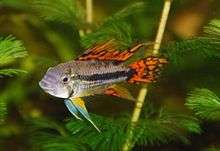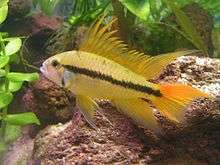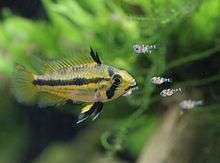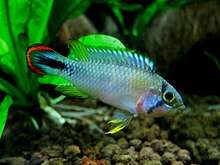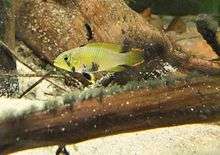Apistogramma
Apistogramma is a large genus of freshwater fish in the family Cichlidae found in South America, but also commonly kept in aquariums. They are dwarf cichlids that mostly feed on tiny animals and have breeding behaviors that vary depending on the exact species.[1][2]
| Apistogramma | |
|---|---|
 | |
| Apistogramma bitaeniata | |
.jpg) | |
| Apistogramma hongsloi | |
| Scientific classification | |
| Kingdom: | Animalia |
| Phylum: | Chordata |
| Class: | Actinopterygii |
| Order: | Cichliformes |
| Family: | Cichlidae |
| Subfamily: | Cichlinae |
| Tribe: | Geophagini |
| Subtribe: | Geophagina |
| Genus: | Apistogramma Regan, 1913 |
| Type species | |
| Mesops taeniatus Günther, 1862 | |
| Synonyms | |
|
Heterogramma Regan, 1906 | |
Range, conservation status and habitat
Apistogramma are exclusively found in tropical and subtropical South America in the lowlands east of the Andes. The highest richness is in the western Amazon Basin and Orinoco Basin, but there are also species in the Guianan Shield, eastern Amazon Basin, rivers flowing into the Atlantic in northern Brazil (Tocantins–Araguaia to Parnaíba) and the Río de la Plata Basin.[1][2][3][4] Although a few species are widespread, most members of this genus have small ranges.[4][5] Few members of the genus have been evaluated by the IUCN, mostly either ranking as least concern (not threatened) or data deficient (limited available data prevents an evaluation), but some of the highly localized Apistogramma species likely are threatened.[5][6][7] Primary threats to their survival are deforestation (causing changes in their microhabitat) and pollution (for example by oil drilling or mining).[6][7]
Apistogramma generally inhabit streams, or edges of rivers or lakes.[2] Most prefer sheltered habitats with leaf litter on the bottom in water with little movement and a shallow depth, up to about 40 cm (1.3 ft), although a few species occur deeper, in fast-flowing water, in more open habitats or at the surface among floating plants.[3][8]
Appearance
Apistogramma are dwarf cichlids with adults reaching between 2 and 8 cm (0.8–3.1 in) in standard length depending on exact species.[1][2] Most species are strongly sexually dimorphic, with males generally larger than females and possessing different color patterns than the females (which at least when breeding are most frequently yellow with blackish markings); in a few species this pattern is reversed or the sexes are rather similar.[1][2][9] Additionally, they often change color depending on behavior, for example when looking for food, breeding or during aggressive encounters.[10] A few species, including A. agassizii, A. cacatuoides, A hongsloi and A. macmasteri, have been selectively bred by aquarists to achieve brighter colors than the natural, wild forms.[11][12][13][14]
Behavior
Apistogramma are omnivores, but tending towards micropredatory. Their main food items consist of aquatic insect larvae and other small invertebrates, fish fry, algae and plant debris.[2][9]
Brood care is highly developed, as in most cichlids. Nearly all Apistogramma species spawn in crevices (small caves), typically in holes in sunken logs or branches, or in leaf litter aggregations. A number of breeding strategies exist in the genus. Some species breed in polygamous harems, while other species form monogamous pairs.[2] Three of the described species, A. barlowi, A. megastoma and A. pantalone, practice mouthbrooding, either by both parents or only by the female.[15][16] In most cases, regardless of the breeding strategy, the female is more highly involved with care of the eggs and fry, whilst the male defends a territory from predators.[2] The sex of the fry is affected by the water conditions: In all species where it has been studied warmer water results in more males and in some species more acidic water (lower pH) also results in more males.[17][18]
Taxonomy and species
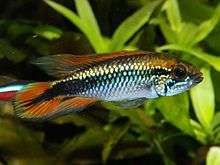
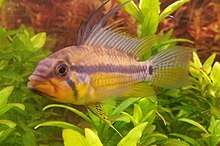

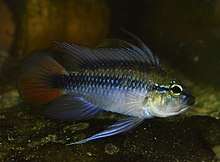
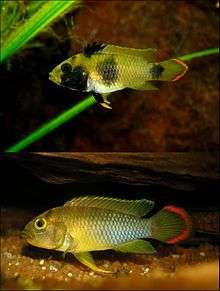
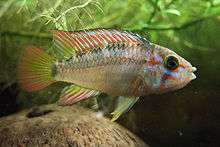
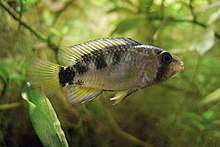
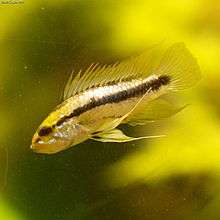
Apistogramma is part of Geophagini and its closest relatives are Apistogrammoides and Taeniacara.[19] There are currently 93 recognized Apistogramma species,[1][20] making it the most species-rich genus of cichlid in the Americas, together with Crenicichla.[4] New species of Apistogramma are regularly described,[8] and undescribed species—sometimes cryptic—are known to exist in the genus.[21] Several of the recognized species occur in more than one form,[4] and some of these actually may represent separate species, as appears to be the case for the "Papagayo" and "Pebás" forms, both typically included in A. ortegai.[5] A comprehensive taxonomic review of the genus is necessary.[2] The genus is sometimes divided into subgroups based on the appearance and phylogenetic relationship of the various species.[4][5]
- Apistogramma acrensis Staeck, 2003
- Apistogramma agassizii (Steindachner, 1875)
- Apistogramma aguarico Römer & Hahn, 2013[22]
- Apistogramma alacrina S. O. Kullander, 2004
- Apistogramma allpahuayo Römer, Beninde, Duponchelle, Vela Díaz, Ortega, Hahn, Soares, Díaz Cachay, García-Dávila, Sirvas-Cornejo & Renno, 2012[23]
- Apistogramma amoena (Cope, 1872)
- Apistogramma angayuara S. O. Kullander & E. F. G. Ferreira, 2005
- Apistogramma arua Römer & Warzel, 1998
- Apistogramma atahualpa Römer, 1997
- Apistogramma baenschi Römer, Hahn, Römer, Soares & Wöhler, 2004
- Apistogramma barlowi Römer & Hahn, 2008
- Apistogramma bitaeniata Pellegrin, 1936
- Apistogramma borellii (Regan, 1906)
- Apistogramma brevis S. O. Kullander, 1980
- Apistogramma cacatuoides Hoedeman, 1951
- Apistogramma caetei S. O. Kullander, 1980
- Apistogramma caudomaculata Mesa_Salazar & Lasso, 2011[24]
- Apistogramma cinilabra Römer, Duponchelle, Vela Díaz, García-Dávila, Sirvas-Cornejo, Díaz Cachay & Renno, 2011[6]
- Apistogramma commbrae (Regan, 1906)
- Apistogramma cruzi S. O. Kullander, 1986
- Apistogramma diplotaenia S. O. Kullander, 1987
- Apistogramma eleutheria Varella & Britzke, 2016[25]
- Apistogramma elizabethae S. O. Kullander, 1980
- Apistogramma eremnopyge Ready & S. O. Kullander, 2004
- Apistogramma erythrura Staeck & I. Schindler, 2008
- Apistogramma eunotus S. O. Kullander, 1981
- Apistogramma feconat Römer, Soares, García-Dávila, Duponchelle, Renno & Hahn, 2015[7]
- Apistogramma flabellicauda Mesa-Salazar & Lasso, 2011[24]
- Apistogramma flavipedunculata Varella & Britzke, 2016[25]
- Apistogramma geisleri Meinken, 1971
- Apistogramma gephyra S. O. Kullander, 1980
- Apistogramma gibbiceps Meinken, 1969
- Apistogramma gossei S. O. Kullander, 1982
- Apistogramma guttata Antonio C., S. O. Kullander & Lasso A., 1989
- Apistogramma helkeri Schindler & Staeck, 2013[26]
- Apistogramma hippolytae S. O. Kullander, 1982
- Apistogramma hoignei Meinken, 1965
- Apistogramma hongsloi S. O. Kullander, 1979
- Apistogramma huascar Römer, Pretor & Hahn, 2006
- Apistogramma inconspicua S. O. Kullander, 1983
- Apistogramma iniridae S. O. Kullander, 1979
- Apistogramma inornata Staeck, 2003
- Apistogramma intermedia Mesa-Salazar & Lasso, 2011[24]
- Apistogramma juruensis S. O. Kullander, 1986
- Apistogramma kullanderi Varella & Sabaj Pérez, 2014[27]
- Apistogramma lineata Mesa-Salazar & Lasso, 2011[24]
- Apistogramma linkei Koslowski, 1985
- Apistogramma luelingi S. O. Kullander, 1976
- Apistogramma macmasteri S. O. Kullander, 1979
- Apistogramma martini Römer, Hahn, Römer, Soares & Wöhler, 2003
- Apistogramma megaptera Mesa Salazar & Lasso, 2011[28]
- Apistogramma megastoma Römer, Römer, Estivals, Vela DíazGarcía-Dávila, Duponchelle, Hahn & Renno, 2017[15]
- Apistogramma meinkeni S. O. Kullander, 1980
- Apistogramma mendezi U. Römer, 1994
- Apistogramma minima Mesa S. & Lasso A., 2011[24]
- Apistogramma moae S. O. Kullander, 1980
- Apistogramma nijsseni S. O. Kullander, 1979
- Apistogramma norberti Staeck, 1991
- Apistogramma nororientalis Mesa-Salazar & Lasso, 2011[24]
- Apistogramma ortegai Britzke, C. de Oliveira & S. O. Kullander, 2014[29]
- Apistogramma ortmanni (C. H. Eigenmann, 1912)
- Apistogramma panduro U. Römer, 1997
- Apistogramma pantalone Römer, Römer, Soares & Hahn, 2006
- Apistogramma paucisquamis S. O. Kullander & Staeck, 1988
- Apistogramma paulmuelleri Römer, Beninde, Duponchelle, García-Dávila, Vela Díaz & Renno, 2013[30]
- Apistogramma payaminonis S. O. Kullander, 1986[7]
- Apistogramma pedunculata Mesa-Salazar & Lasso, 2011[24]
- Apistogramma personata S. O. Kullander, 1980
- Apistogramma pertensis (Haseman, 1911)
- Apistogramma piaroa Mesa-Salazar & Lasso, 2011[24]
- Apistogramma piauiensis S. O. Kullander, 1980
- Apistogramma playayacu Römer, Beninde & Hahn, 2011[31]
- Apistogramma pleurotaenia (Regan, 1909)
- Apistogramma psammophila Staeck & Schindler, 2019[8]
- Apistogramma pulchra S. O. Kullander, 1980
- Apistogramma regani S. O. Kullander, 1980
- Apistogramma resticulosa S. O. Kullander, 1980
- Apistogramma rositae Römer, Römer & Hahn, 2006
- Apistogramma rubrolineata Hein, Zarske & Zapata, 2002
- Apistogramma rupununi Fowler, 1914
- Apistogramma salpinction S. O. Kullander & E. F. G. Ferreira, 2005
- Apistogramma similis Staeck, 2003
- Apistogramma sororcula Staeck & Schindler, 2016[32]
- Apistogramma staecki Koslowski, 1985
- Apistogramma steindachneri (Regan, 1908)
- Apistogramma taeniata (Günther, 1862)
- Apistogramma trifasciata (C. H. Eigenmann & C. H. Kennedy, 1903)
- Apistogramma tucurui Staeck, 2003
- Apistogramma uaupesi S. O. Kullander, 1980
- Apistogramma urteagai S. O. Kullander, 1986
- Apistogramma velifera Staeck, 2003
- Apistogramma viejita S. O. Kullander, 1979
- Apistogramma wapisana U. Römer, Hahn & Conrad, 2006
- Apistogramma wolli Römer, Soares, García-Dávila, Duponchelle, Renno & Hahn, 2015[7]
References
- Froese, Rainer and Pauly, Daniel, eds. (2019). Species of Apistogramma in FishBase. July 2019 version.
- van der Sleen, P.; J.S. Albert, eds. (2017). Field Guide to the Fishes of the Amazon, Orinoco, and Guianas. Princeton University Press. pp. 366–367. ISBN 978-0691170749.
- Kullander, S.O., and E.J.G. Ferreira (2005). Two new species of Apistogramma Regan (Teleostei: Cichlidae) from the rio Trombetas, Pará State, Brazil. Neotrop. ichthyol. 3(3). doi:10.1590/S1679-62252005000300003
- Wise, M. (1 October 2017). "Apistogramma Species List By Species-Groups/Complexes". Apisto sites. Archived from the original on 26 September 2018.
- Tougard, C., C.R.G. Dávila, U. Römer, F. Duponchelle, F. Cerqueira, E. Paradis, B. Guinand, C.A. Chávez, V. Salas, S. Quérouil, S. Sirvas, and J.-F. Renno (2017). Tempo and rates of diversification in the South American cichlid genus Apistogramma (Teleostei: Perciformes: Cichlidae). PLoS ONE 12(9): e0182618. doi:10.1371/journal.pone.0182618
- Römer, U., Duponchelle, F., Vela Diaz, A., Garcia Davilla, C., Sirvas, S., Diaz Catchay, C. & Renno, J.-F. (2011): Apistogramma cinilabra sp. n.: Description of a potentially endangered endemic cichlid species (Teleostei: Perciformes: Cichlidae) from the Departamento Loreto, Peru. Vertebrate Zoology, 61 (1): 3-23.
- Römer, U., Soares, D.P., García Dávila, C.R., Duponchelle, F., Renno, J.-F. & Hahn, I. (2015): Re-description of Apistogramma payaminonis Kullander, 1986, with descriptions of two new cichlid species of the genus Apistogramma (Teleostei, Perciformes, Geophaginae) from northern Peru. Vertebrate Zoology, 65 (3): 305–332.
- Staeck, W., and I. Schindler (2019). Apistogramma psammophila – a new geophagine dwarf cichlid (Teleostei: Cichlidae) from the Rio Atabapo drainage in Colombia and Venezuela. Vertebrate Zoology 69(1): 103-110.
- Rodrigues, R.R., J. Zuanon, K. Del-Claro, and L.N. Carvalho (2012). Reproductive behavior of the Amazonian dwarf cichlid Apistogramma hippolytae Kullander, 1982: offsetting costs and benefits. Acta Ethologica 15(1): 1-7. doi:10.1007/s10211-011-0107-8.
- Rodrigues, R.R., L.N. Carvalho, J. Zuanon, and K. Del-Claro (2009). Color changing and behavioral context in the Amazonian Dwarf Cichlid Apistogramma hippolytae (Perciformes). Neotrop. ichthyol. 7(4). doi:10.1590/S1679-62252009000400013
- "Apistogramma agassizii". SeriouslyFish. Retrieved 10 July 2019.
- "Apistogramma cacatuoides". SeriouslyFish. Retrieved 10 July 2019.
- "Apistogramma hongsloi". dwarfcichlid.com. Retrieved 10 July 2019.
- "Apistogramma macmasteri". SeriouslyFish. Retrieved 10 July 2019.
- Römer, U.; C.I. Römer; G. Estivals; A.V. Díaz; F. Duponchelle; C.R.G Dávila; I. Hahn; J.-F. Renn (2017). "Description of a new maternal larvophilic mouth-brooding cichlid species, Apistogramma megastoma sp. n. (Teleostei: Perciformes: Geophaginae), from Loreto, Peru". Vertebrate Zoology. 467 (2): 151–171.
- Römer, C.I.; U. Römer; I. Hahn; D.P. Soares (2018). "Beiträge zur Biologie von Apistogramma-Arten: Auch Apistogramma pantalone Römer et al., 2006 ist ein fakultativer Maulbrüter". DCG-Informationen. 49 (9): 202–211.
- Römer, U., and W. Beisenherz (1996). Environmental determination of sex in Apistogramma (Cichlidae) and two other freshwater fishes (Teleostei). Journal of Fish Biology 48(4): 714-725. doi:10.1111/j.1095-8649.1996.tb01467.x
- Ospina-Álvarez, N., and F. Piferrer (2008). Temperature-dependent sex determination in fish revisited: Prevalence, a single sex ratio response pattern, and possible effects of climate change. PLoS One 3(7): e2837. doi:10.1371/journal.pone.0002837
- López-Fernández, H., R.L. Honeycutt, M.L.J. Stiassny, and K.O. Winemiller (2005). Morphology, molecules, and character congruence in the phylogeny of South American geophagine cichlids (Perciformes, Labroidei). Zoologica Scripta 34(6): 627–651. doi:10.1111/j.1463-6409.2005.00209.x
- Eschmeyer, W. N.; R. Fricke & R. van der Laan (eds.). "Apistogramma species". Catalog of Fishes. California Academy of Sciences. Retrieved 10 July 2019.
- Carvalho, A.P.C., R.A. Collins, J.G. Martínez, I.P. Farias, and T. Hrbek (2019). From shallow to deep divergences: mixed messages from Amazon Basin cichlids. Hydrobiologia 832(1): 317–329. doi:10.1007/s10750-018-3790-x
- Römer, U. & Hahn, I. (2013): Apistogramma aguarico sp. n.: A new species of geophagine cichlid fish (Teleostei: Perciformes) from the Ecuadorian and Peruvian río Napo system. Vertebrate Zoology, 63 (2): 171-181.
- Römer, U., Beninde, J., Duponchelle, F., Vela Díaz, A., Ortega, H., Hahn, I., Soares, D.P., Díaz Cachay, C., García Dávila, C.R., Sirvas Cornejo, S. & Renno, J.-F. (2012): Description of Apistogramma allpahuayo sp. n., a new dwarf cichlid species (Teleostei: Perciformes: Geophaginae) from in and around the Reserva Nacional Allpahuayo Mishana, Loreto, Peru. Vertebrate Zoology, 62 (2): 189–212.
- Mesa S., L.M. & Lasso, C.A. (2011). Revisión del género Apistogramma Regan, 1913 (Perciformes, Cichlidae) en la cuenca del río Orinoco. Serie Editorial Recursos Hidrobiológicos y Pesqueros Continentales de Colombia. Instituto de Investigación de Recursos Biológicos Alexander von Humboldt. p. 192. ISBN 978-958-8343-64-8.CS1 maint: uses authors parameter (link)
- Varella, H.R. & Britzke, R. (2016): Apistogramma eleutheria and A. flavipedunculata, two new species of dwarf cichlids from the rio Curuá on Serra do Cachimbo, Brazil (Teleostei: Cichlidae). Ichthyological Exploration of Freshwaters, 27 (1): 81-95.
- Schindler, I. & Staeck, W. (2013): Description of Apistogramma helkeri sp. n., a new geophagine dwarf cichlid (Teleostei: Cichlidae) from the lower río Cuao (Orinoco drainage) in Venezuela. Vertebrate Zoology, 63 (3): 301-306.
- Varella, H.R. & Sabaj Pérez, M.H. (2014): A titan among dwarfs: Apistogramma kullanderi, new species (Teleostei: Cichlidae). Ichthyological Exploration of Freshwaters, 25 (3): 243-258.
- Mesa Salazar, L.M. & Lasso, C.A. (2011): Apistogramma megaptera (Perciformes: Cichlidae), una nueva especie para la cuenca del Orinoco. Biota Colombiana, 12 (1): 19-30.
- Britzke, R., Oliveira, C. & Kullander, S.O. (2014): Apistogramma ortegai (Teleostei: Cichlidae), a new species of cichlid fish from the Ampyiacu River in the Peruvian Amazon basin. Zootaxa, 3869 (4): 409–419.
- Römer, U., Beninde, J., Duponchelle, F., García Dávila, C.R., Vela Díaz, A. & Renno, J.-F. (2013): Description of Apistogramma paulmuelleri sp. n., a new geophagine cichlid species (Teleostei: Perciformes) from the Amazon river basin in Loreto, Peru. Vertebrate Zoology, 63 (1): 15-34.
- Römer, U., Beninde, J. & Hahn, I. (2011): Apistogramma playayacu sp. n.: Description of a new cichlid species (Teleostei: Perciformes: Geophaginae) from the Rio Napo system, Ecuador. Vertebrate Zoology, 61 (3): 321-333.
- Staeck, W. & Schindler, I. (2016): Apistogramma sororcula, a new dwarf cichlid (Teleostei: Cichlidae) from the drainage of the rio Guaporé in Bolivia and Brazil. Vertebrate Zoology, 66 (2): 141-150.
